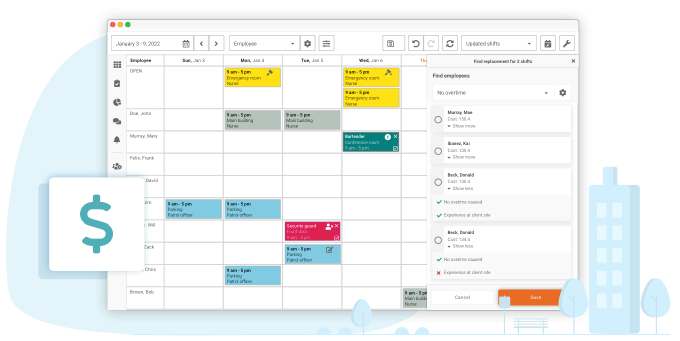Employee scheduling is a complex function of workforce management. Here at Celayix, we’ve worked with clients where it takes almost 2 weeks to create a monthly employee schedule! Of course, this just isn’t efficient, or practical. Below, we break down how schedule workflows can drastically reduce time spent scheduling, and even improve schedule quality. Of course, having employee scheduling software in-house is one of the first steps to being able to achieve these workflows.
What Are Workflows?

A workflow is a series of steps that execute in a specific order to meet a certain objective. There are many workflows in any organization, and it is important that the software that you choose reflects your company’s workflows.
Organizations have workflows for scheduling, checking employees in and out of shifts, processing payroll, and countless other processes. Setting up workflows can help you save time and can automate processes. In the context of scheduling, using workflows can save you numerous hours each week. To demonstrate how a schedule workflow works, we’ll use the example of employee vacation requests.
Vacation Request Workflow
Vacations are important for work-life balance and employee health. Not to mention, almost all employee agreements have clauses to address vacation. For the employer, it’s crucial that vacations have minimal disruption and interference to business operations. Most times, having other employees to cover is sufficient.
Depending on the organization, there are rules that govern employee vacations. For example, employees must give adequate notice as defined by the employer. Specific dates may be unavailable for vacation due to business operations. Vacation requests also require approvals from managers.
While vacation requests appear to be a simple action, there are many steps that go into it. Using a workflow in employee scheduling software can simplify the process. Here is how scheduling software can help:

- Employees can easily see how many days/hours of vacation they can take
- They can easily choose the dates of their vacation
- If needed, they can enter notes about the vacation (e.g., the reason, alternative dates, etc.)
- Once they submit the request, the manager(s) can approve or deny the request
- Employees can see the status of their request (e.g., pending, approved, denied) and any additional comments their manager(s) have made
The workflow mimics a paper-based process of an employee filling out a vacation request form. With scheduling software, there is no risk of losing a record of the request. In addition, the software automatically incorporates the request into payroll.
On the manager’s end, they can easily see approved vacation requests during the scheduling process. The data the software collects is also useful for scheduling and workforce planning. Managers can generate reports that show total vacation hours, common dates and times for vacation, and so on.
Benefits of Employee Schedule Workflows
Save time on scheduling

Of course, the main purpose and benefit of schedule workflows are time-saving. When there are set steps to take, most of which are automated, schedulers can truly reduce the time spent scheduling. These time savings are not just a benefit to the scheduler. Managers who spend most of their time creating employee schedules can then be freed up to work elsewhere. Their time and efforts can be used to grow the business, train employees, or attract new customers. It goes without saying that all of this contributes to an improved bottom line.
Reduce Errors
Schedule workflows can reduce errors in many areas of your business. Of course, as we mentioned above, it reduces the likelihood of loosing time off/vacation requests. Not only that but when there are schedule workflows that link into payroll, there is a far lower chance of payroll errors. According to the APA, 33% of employers make payroll errors costing billions of dollars annually. Any opportunity to save on these errors should certainly be taken advantage of.
Happier Employees
Finally, schedule workflows ultimately lead to happier employees. As you consistently use workflows to create optimized employee schedules, employees will reap the rewards. Work-life balance, regular hours, fair assignment of shifts, and less overtime are generally appreciated by everyone involved. As you can imagine, happier employees are more engaged, productive, and less likely to leave. Employee retention is something all businesses strive to improve.
Conclusion
If a company’s employee scheduling software doesn’t have the flexibility to manage all parts of scheduling workflows, additional effort must be made in other systems to track this information in other applications. Extra work may be required to ensure all the necessary systems are updated with the correct information. It is easy, in that situation, for errors to creep into play, costing the company, and maybe even the employees, losing valuable time and/or money, increasing their frustration, and creating extra unnecessary work for employees and management.
Celayix’s employee scheduling software provides the power and flexibility to meet the most demanding requirements of scheduling workflows. To see how a software solution can adapt to your workflows, instead of you having to adapt to a rigid workflow dictated by the software, contact Celayix to arrange a free live demonstration today.





